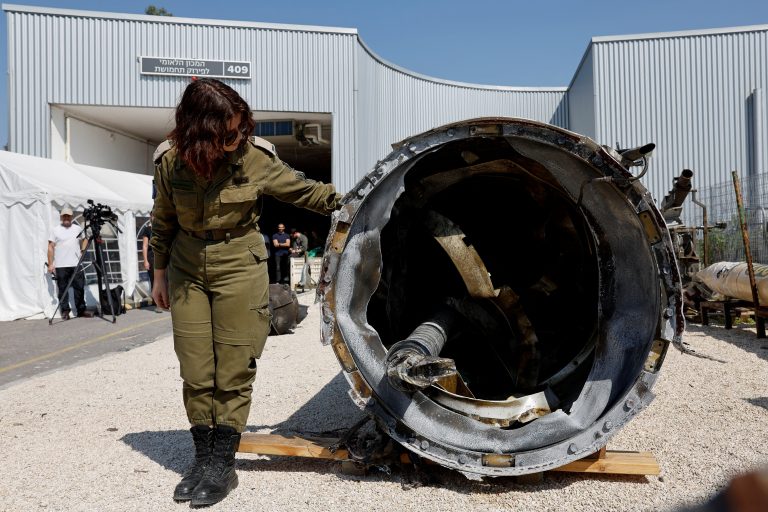On June 14, it was revealed that Temerland, an Ukrainian robotics and weapons manufacturer based in Zaporizhia, Ukraine will be deploying a robotic battlefield scout, a killer robot, next week called GNOM (“Gnome”) to the front lines of the war which can be operated remotely and is armed with a machine gun.
According to the company, the robot is relatively small weighing only 50 kilograms (110.23 pounds) and measures just two feet in length and is less than two feet wide, not much larger than a typical microwave.
It can perform tasks such as surveillance and can transport equipment. It can also be used as a mobile fire-support platform.
The robot is propelled by a quiet 5-horsepower electric motor on four large wheels with 4X4 drive. The most current version is armed with a 7.62mm machine gun.
Unlike most UGVs (unmanned ground vehicles), that are radio controlled, the GNOM spools out a reel of fiber-optic cable behind it, allowing for lightning fast communication with the robot while making it immune to radio countermeasures. Since they do not operate by radio they cannot be detected and targeted by artillery.
Success
You are now signed up for our newsletter
Success
Check your email to complete sign up
GNOM’s fiber-optic cable gives it a range of two kilometers (1.25 miles) and if broken the robot will autonomously return to a predetermined location, meaning it is capable of autonomous navigation.
Timberland’s previous designs included an advanced neural network and machine learning hardware and software that provided their robots with a high degree of autonomy, Forbes reported.
Eduard Trotsenko, CEO and owner of Temerland, told Forbes, “Control of GNOM is possible in the most aggressive environment during the operation of the enemy’s electronic warfare equipment. The operator doesn’t deploy a control station with an antenna, and does not unmask its position.The cable is not visible, and it also does not create thermal radiation that could be seen by a thermal imager.”
Despite the robots impressive characteristics experts are skeptical about how the robot may actually perform in live combat.
Samuel Bendett, an analyst at the Center for Naval Analysis and adjunct senior fellow at the Center for New American Security, told Task and Purpose, “Building something that is small and cheap and also has capabilities to enable multifunctional capabilities is fairly difficult. Its actual utility is something that we have to scrutinize closely.”
“The function of a UGV [unmanned ground vehicle] is ultimately to replace a human fighter. But humans can communicate. They can adapt. They can form units and attack,” he said.
Bendett believes that UGVs are not quite developed enough to be effective in live combat, saying that full autonomy is the brass ring. “The ultimate usage is fully autonomous usage, but we are many years away from that. But this is part of advertising capabilities, part of the evolution of UGVs.” he said.
READ MORE:
- US Sending 100 Switchblade Drones to Ukraine as Part of a $800 Million Package to Fight the Russians
- Synthetic Biology: The New Paradigm of Genetic Engineering
- Scientists Invent World’s First Self-Replicating Robots, Raising Fears of a ‘Gray Goo’ Catastrophe
Russia appears to deploy a UVG
In April, footage emerged that seemingly showed that Russia had deployed a Uran-6 UGV in an unknown location somewhere in the Luhansk region of Ukraine.
A Uran-6 UGV is a robotic land vehicle that is designed for detecting and clearing landmines.
The Uran-6 can be transported by air, sea and land and weighs approximately six tons. Its dimensions are 4.5 meters (14.7 feet) long, 2 meters (6.5 feet) wide and 1.5 meters (4.9 feet) high.
The robot is equipped with four cameras at the top allowing its operator to receive a 360-degree view of its surroundings in real time. It requires only a single operator.
It can be operated remotely at a distance of up to 1 kilometer (0.62 miles) and is outfitted with a bulldozer blade, a self-propelled minesweeper, a robotic arm, a massive cutter a power tiller, a trailer, a crane and a clamp with a load capacity of 1000 kg (2204 pounds).
Reportedly, the Uran-6 can survive a mine blast of 60kg of TNT and can clear anti-personnel mines and hazardous substances weighing anywhere from 1kg to 4kg or anywhere from 2.2 pounds to 8.8 pounds.
It’s powered by a 240hp diesel engine and when mine-clearing travels at just 2km/h to a maximum speed of 5km/h and can operate continuously for up to five hours.

Stop Killer Robots
The rising use of robots by militaries across the globe to wage warfare has prompted some to raise the alarm about their use.
Stop Killer Robots (SKR), is a not-for-profit which was launched in 2013 and operates globally with 180+ member organizations. According to its website it’s “a united voice with national, regional and international effect.”
In March of this year the organization raised the alarm about the use of robots on the front lines of the war in Ukraine.
“Stop Killer Robots is deeply concerned with reports of weapons systems being used that may have options for autonomous targeting,” the organization wrote in a blog post earlier this year.
Of particular concern for the organization is the use of the KUB-BLA, a “loitering munition.”
The KUB-BLA is similar to the Switchblade drones that the U.S. supplied Ukraine with earlier this year as part of an $800-million military aid package.
The KUB-BLA has a range of 24-miles and can reach speeds of up to 80 miles per hour. It can be armed with a 2.2-pound warhead that shoots out metal balls in order to maim its target. At only about three-feet long it can stay aloft for around 30-minutes.
Stop Killer Robots believes that the drone’s onboard target guidance system gives the weapon the ability to act on its own with no human input raising several ethical and legal concerns.
While SKR says that the information available on whether or not the drone could be unleashed to autonomously operate is murky it says that “the role of the human operator is becoming blurred” and overtime, human input appears to be at risk of declining over time.
“With more than 70 countries having called for a legal instrument on autonomy in weapons systems, it is time to move to the negotiation of a treaty that preserves human dignity and maintains meaningful human control,” SKR wrote.
















